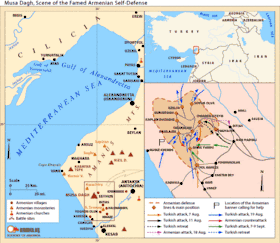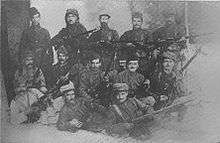Musa Dagh
| Musa Dagh defense | |||||||
|---|---|---|---|---|---|---|---|
| Part of the Armenian Genocide | |||||||
 Map of the Musa Dagh Armenian Self-Defense. | |||||||
| |||||||
| Belligerents | |||||||
|
| Armenian civilians | ||||||
| Commanders and leaders | |||||||
| Unknown | Yesayi Yakhubian, Yesayi Aprahamian, Nerses Kazandjian, Movses Ter-Kalutsian and others | ||||||
| Strength | |||||||
| around 20,000 by the end | 250[1] 4,000 Armenian Civilians | ||||||
| Casualties and losses | |||||||
| heavy | unknown | ||||||
Musa Dagh (Turkish: Musa Dağı; Armenian: Մուսա լեռ, Musa leṛ;[2] Arabic: جبل موسى Jebel Musa; meaning "Moses Mountain") is a mountain in the Hatay province of Turkey. In 1915 it was the location of a successful Armenian resistance to the Armenian Genocide, an event that inspired Franz Werfel to write the novel The Forty Days of Musa Dagh.
History

The deportation of the Armenian population of current Turkey, ordered by the Ottoman Empire, in July 1915 reached the six Armenian villages of the Musa Dagh region: Kabusia (Kaboussieh), Yoghunoluk, Bitias, Vakef, Kheter Bey (Khodr Bey) and Haji Habibli.[3] As Ottoman Turkish forces converged upon the town, the populace, aware of the impending danger, refused deportation and fell back upon Musa mountain, thwarting assaults for fifty-three days, from July to September 1915.[4][5] One of the leaders of the revolt was Movses Der Kalousdian, whose Armenian first name was the same as that of the mountain. Allied warships, most notably the French 3rd squadron in the Mediterranean under command of Louis Dartige du Fournet, sighted the survivors, just as ammunition and food provisions were running out.[6] French and British ships, beginning with the Guichen, evacuated 4,200 men, women and children from Musa Dagh to safety in Port Said.[7][8][9] Starting in 1918, when the Sanjak of Alexandretta came under French control, the population of the six Armenian villages returned to their homes. In 1932 a monument was erected at the top of the mountain to commemorate the event.[10]
On 29 June 1939, following an agreement between France and Turkey, the province was given to Turkey. Afterwards Armenians from six of the villages emigrated from Hatay, while some of the residents of Vakıflı village chose to stay.[11] Vakıflı is the only remaining ethnic Armenian village in Turkey,[12][13] with a population only 140 Turkish-Armenians. Most who left Hatay in 1939 emigrated to Lebanon where they resettled in the town of Anjar. Today, the town of Anjar is divided into six districts, each commemorating one of the villages of Musa Dagh.
As the French squads came to the rescue of the remaining survivors, the chief priest was quoted to say: "The evil only happened ... to enable God to show us His goodness."[14] This event was depicted in the 2016 movie The Promise.
The Forty Days of Musa Dagh

These historical events later inspired Franz Werfel to write his novel The Forty Days of Musa Dagh (1933), a fictionalized account based on his detailed research of historical sources. Werfel told reporters: "The struggle of 5,000 people on Musa Dagh had so fascinated me that I wished to aid the Armenian people by writing about it and bringing it to the world".[15] A movie of the same name was released in 1982.[16]
See also
References
- ↑ The Burning Tigris: The Armenian Genocide and America's Response By Peter Balakian, p.210
- ↑ Adalian, Rouben. Historical Dictionary of Armenia. p. 449.
- ↑ New Outlook, Volume 111 edited by Alfred Emanuel Smith, page.800
- ↑ Remembrance and denial: the case of the Armenian genocide by Richard G. Hovannisian – Page 161
- ↑ Resistance and revenge: the Armenian assassination of the Turkish leaders ... By Jacques Derogy p.22
- ↑ Franz Werfel: an Austrian writer reassessed – by Lothar Huber, page 176
- ↑ The great war for civilisation: the conquest of the Middle East by Robert Fisk.
- ↑ The Christian minorities in Turkey – Wilhelm Baum, p. 92.
- ↑ The new presence by Nadace M.J. Stránského, p.14.
- ↑ "La Reconnaissance Armenienne" in "l'Illustration" page XXII, 29 October 1932.
- ↑ Başlangıç, Celal (29 July 2002). "Musa'dan notlar" (in Turkish). Radikal. Retrieved 2007-02-22.
- ↑ Kalkan, Ersin (31 July 2005). "Türkiye'nin tek Ermeni köyü Vakıflı" (in Turkish). Hürriyet. Retrieved 2007-02-22.
- ↑ Campbell, Verity (2007). Turkey. Lonely Planet. ISBN 1741045568.
- ↑ Franz Werfel, the faith of an exile: from Prague to Beverly Hills By Lionel Bradley Steiman, page 86
- ↑ Bobelian, Michael. Children of Armenia: a forgotten genocide and the century-long struggle for justice. p. 83.
- ↑ http://www.imdb.com/title/tt0138989/
External links
- Official Website
- Home of All Musa Daghians & Anjarians
- Armenian National Institute entry on Musa Dagh
Coordinates: 36°15′30″N 35°54′13″E / 36.25833°N 35.90361°E